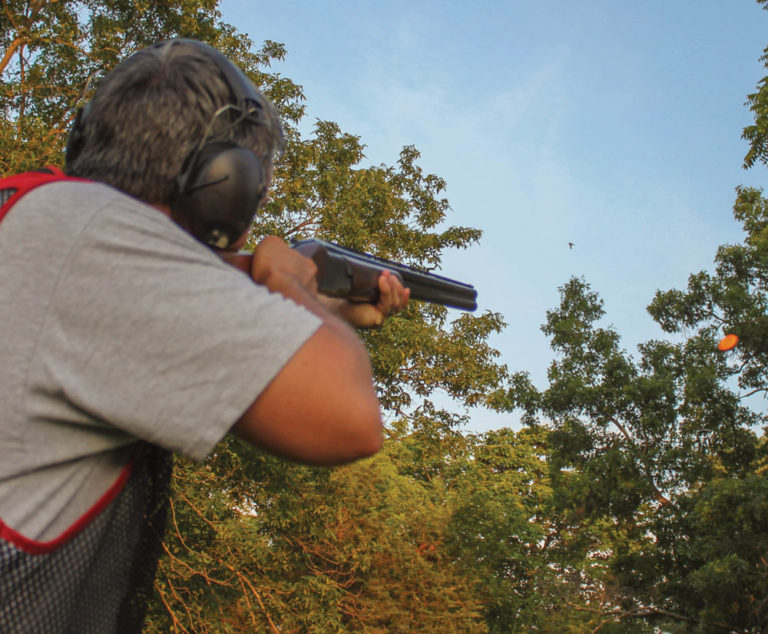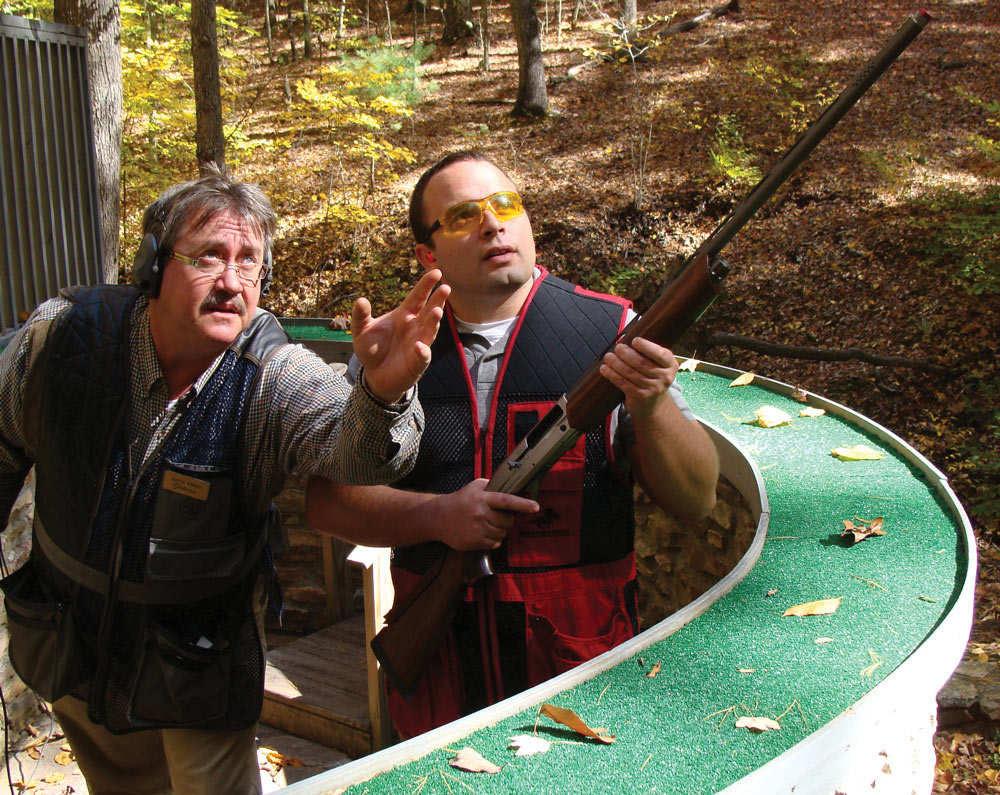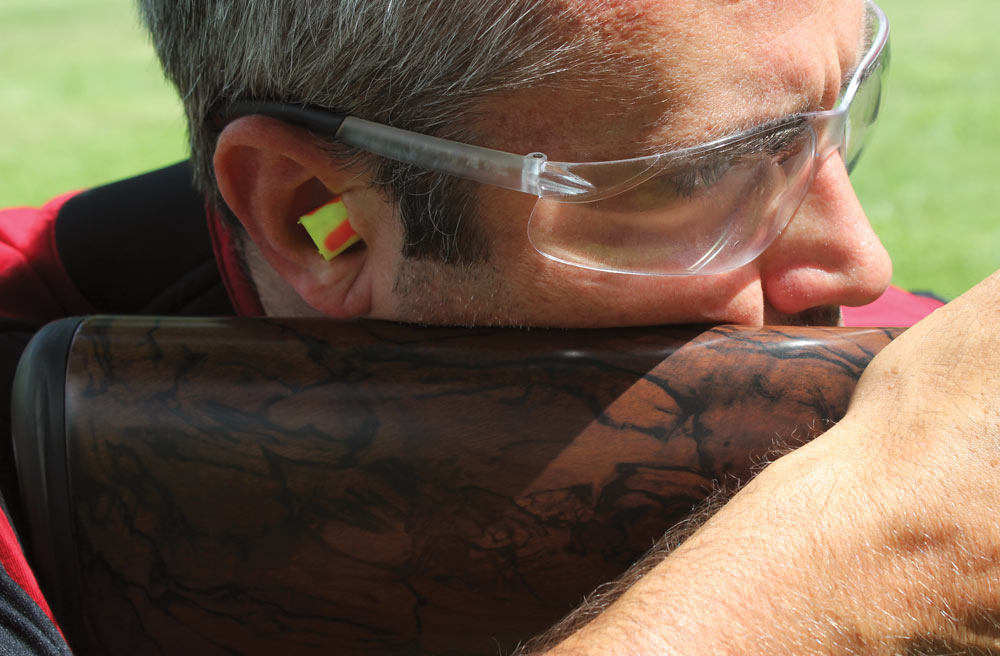

Whether busting birds means heading afield with a brace of pointing dogs or traveling to the range to smash orange discs, here are six shotgunning tips to improve your overall score.
Shotgun basics begin before you’re on the range or in the field. First of all, you need to understand the basic tenets of successful shooting. Developing a proper shooting stance is the first step in successful shotgunning. To begin, your front leg (opposite your shooting hand) should be slightly forward, knees should be roughly shoulder width apart and bent slightly. Your feet should be firmly planted, but you should be comfortable, and your foot position shouldn’t impair your swing.
For lateral movements, you rotate at the hips; the upper body remains fixed, you should maintain a good cheek weld on the shotgun, and the shoulders and head should move with the gun as one solid unit. Elevation changes are accomplished by flexing the back. It’s important that the gun comes up to your eye and that you don’t plant the gun on your shoulder and lower your head to meet the gun. The butt of your shotgun should always land in the same point on the shoulder, and once you’ve got the gun mounted, maintain a steady lock between the upper body and the firearm.
Above all else, remain target focused. Unlike pistol and rifle shooting, which require you to align the sights on the target, shotgun shooters devote total concentration to the bird.

The Crosser
Crossing shots are common in the field when hunting doves or ducks, and the skeet range is the best place to develop your skills. New shooters are often fixated on lead, and they ask how far ahead of the target they should be at every station on the skeet field. If you learn sustained lead, you can do pretty well shooting the invariable list of shots you’ll see at the skeet range, but that isn’t very practical for the field—doves and ducks rarely give you the time to decipher whether you need to be three or five feet ahead of the target, and devotees of sustained lead often end up “riding” the target to find the perfect hold point.
Instead, learn to shoot swing-through. This requires you to keep your eyes on the target, swing the gun to catch up, and press the trigger as you catch and pass the bird. The faster the target is going (say, a dove rocketing by at 60 miles an hour), the faster you’ll be swinging. It takes practice, and you must keep the muzzle moving after the shot, but it will make you a better target and field shooter. Rotate from the hips, and remember to keep your upper body locked to the gun as you swing.
Incoming
You’ll see incoming targets on the skeet range, and it’s a common shot you’ll encounter on decoyed waterfowl. The incoming shot should be relatively easy, but it’s often missed because it happens quickly, and the shooter doesn’t understand the physics of the shot. Unlike crossers, you don’t get behind and swing through an incomer; rather, focus on raising the muzzle up to meet the flight path of the target, and when these two lines intersect, fire and keep swinging. Oftentimes the muzzle will cover the target, and you should fire as the gun is coming up and just a bit ahead of the target’s position so that the shot string intercepts the target. Incoming shots require practice to master, so be sure to spend plenty of time on the skeet range, and always remember to remain target-focused.
Outgoing
This is the classic trap shot and is often encountered when hunting game birds in the field, so it’s important to be proficient. The basic rules are the same for any other shot (good stance, eyes on target, good cheek weld, follow-through). Bring the gun up to the target, and don’t forget that any angling outgoing shot requires some lead, though it won’t be as dramatic as when shooting hard crossing targets. Your gun’s point of impact is particularly important when shooting an outgoing target; some guns shoot very flat, so you’ll have to position the gun higher for the shot. Others, particularly guns designed for trap, tend to have a higher point of impact, often 80/20 (80 percent of the shot will strike at a point above the rib) or even more.

High Overhead
This is a common shot for duck and dove hunters and those who shoot driven birds, and it’s a shot that is becoming more common on sporting clays courses. High overhead shots seem tough, and they can be, but the rules of good shotgunning still apply. If the bird is coming at you, you’ll need to swing through and actually cover the target when you shoot. If the bird is going away, swing ahead and follow through as you press the trigger. The real key here is to keep the upper body fixed with a good cheek weld on the gun and bend your back. This requires practice, and one way you can accomplish this is to raise an unloaded gun to your shoulder and run the bead up and down the length of a vertical target (trees work well), maintaining your focus on the target while flexing and extending your back to track the bead up and down.
The Rabbit
Ah, the rabbit—bane of every sporting clays shooter. These deceptive targets bounce along the ground ahead of the shooter; leaping and lunging in a fashion that seems out-of-sorts with the steady, smooth travel of an aerial clay. But the basic principles remain the same, so be sure to rotate at the hips, keep your eyes on the target, and swing through after the shot. If the rabbit is rolling along the ground, it works in much the same way that a crossing target does, but if it takes a bounce, you’ll need to be tracking through the arch and keep the gun moving as you fire. You’ll need to shoot a bit ahead of the target (most rabbits are missed behind) and, above all else, keep that muzzle moving.
This article originally appeared in the Aug. 7, 2014 edition of Gun Digest the Magazine.

Next Step: Get your FREE Printable Target Pack
Enhance your shooting precision with our 62 MOA Targets, perfect for rifles and handguns. Crafted in collaboration with Storm Tactical for accuracy and versatility.
Subscribe to the Gun Digest email newsletter and get your downloadable target pack sent straight to your inbox. Stay updated with the latest firearms info in the industry.

![Best Concealed Carry Guns In 2025 [Field Tested] Wilson Combat EDC X9S 1](https://gundigest.com/wp-content/uploads/Wilson-Combat-EDC-X9S-1-324x160.jpg)


![Best 9mm Carbine: Affordable PCCs [Tested] Ruger Carbine Shooting](https://gundigest.com/wp-content/uploads/Ruger-Carbine-Shooting-100x70.jpg)
![Best AR-15: Top Options Available Today [Field Tested] Harrington and Richardson PSA XM177E2 feature](https://gundigest.com/wp-content/uploads/Harrington-and-Richardson-PSA-XM177E2-feature-100x70.jpg)
